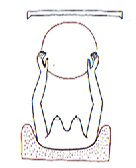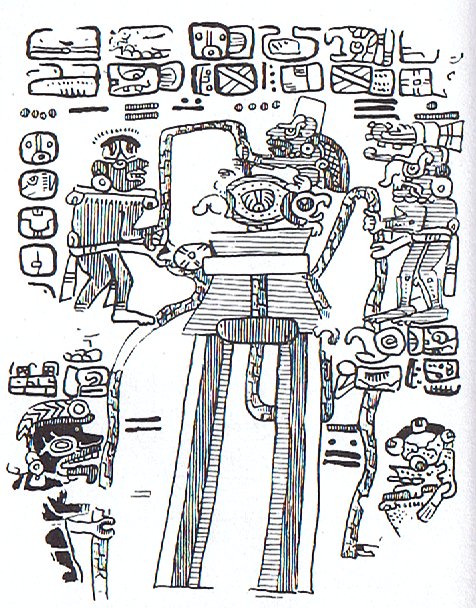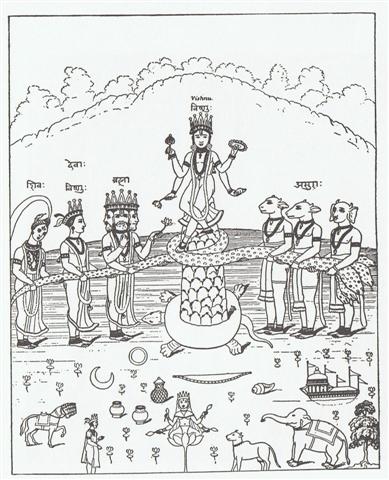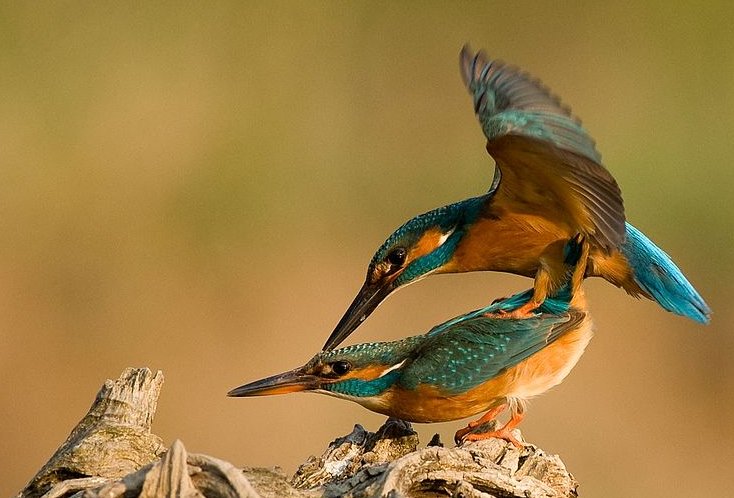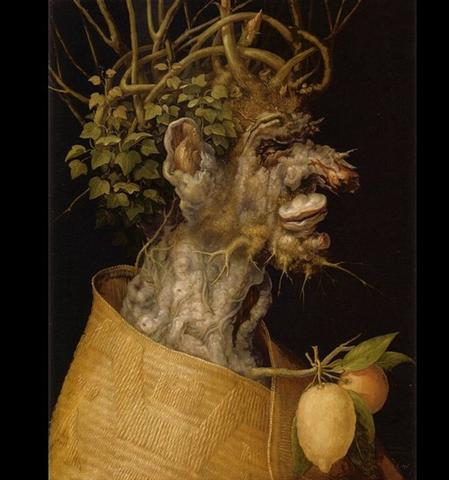The earth turtle (honu) glyphs continues all the way to the Pleiades, which could mean the dark times continued to the Pleiades. Although there seems to be a kind of break ('hole for birth') in the carapace of Mother Earth from *AUGUST 16 (227, i.e. π) - corresponding to October 22 (295 = 227 + 68) - and up to the beginning of line Cb2:
The Crooked-clawed star (Khambalia, λ Virginis) could perhaps define where once upon a time the 'curved' Virgo changed to the 'straight' balanced beam of Libra: ... A bent branch can symbolize 'change'. The 'curved' was according to the Pythagorean school a 'female' trait: '... Freeman describres the dualistic cosmology of the Pythagorean school (-5th century), embodied in a table of ten pairs of opposites. On one side there was the limited, the odd, the one, the right, the male, the good, motion, light, square and straight. On the other side there was the unlimited, the even, the many, the left, the female, the bad, rest, darkness, oblong and curved ...' From this it should be clear that there is a high probability for 'curved' to also imply 'darkness' in the minds of the Easter Islanders. This is one reason (among others) to interpret 'breaking the shadows' as going from the female night to the male day ...
The ana-conda (hena-candāya, lighting-stem) rope seems to lead through the turtle at the top and down through a hole, and later we can see a great reversed turtle head uplifted above 7 inverted fire feathers inside a quadrangular 'dead earth'. These upside down feathers are like the eye-lashes of Death (Cimi), the 6th Mayan day sign:
"Anaconda ... large S. American boa. XIII. First applied to an alleged large snake of Ceylon, app. as an (unexpl.) alteration of anacandaia (Ray 1693), which is for Sinhalese henacandāya 'lighting-stem', whip snake; by some blunder transf. by Daudin to the aquatic boa Eunectes murinus (Boa anacondo)." (C. T. Onions, The Oxford Dictionary of English Etymology.)
This place could therefore have indicated the Pleiades. ... We often see the assertion that our title is in no way connected with Άλκυών, the Halcyon, that 'symbolic or mystical bird, early identified with the Kingfisher', the ornithological Alcedo or Ceryle;
so that although the myth of the Halcyon Days, that 'clement and temperate time, the nurse of the beautiful Halcyon', When birds of calm sit brooding on the charmed wave, is not yet understood, some of Thompson's conjectures as to its stellar aspect will be found interesting. He writes that the story originally referred to some astronomical phenomenon, probably in connexion with the Pleiades, of which constellation Alcyone is the principal star. In what appears to have been the most vigorous period of ancient astronomy (not later than 2000 B.C., but continuing long afterwards to influence legend and nomenclature) the sun rose at the vernal equinox, in conjunction with the Pleiad, in the sign Taurus: the Pleiad is in many languages associated with bird-names ... and I am inclined to take the bird on the bull's back in coins of Eretria, Dicaea, and Thurii for the associated constellation of the Pleiad ... Suidas definitely asserts that the Pleiades were called Άλκυόνες. At the winter solstice, in the same ancient epoch, the Pleiad culminated at nightfall in mid-heaven ... This culmination, between three and four months after the heliacal rising of the Pleiad in Autumn, was, I conjecture, symbolized as the nesting of the Halcyon. Owing to the antiquity and corruption of the legend, it is impossible to hazard more than a conjecture; but that the phenomenon was in some form an astronomic one I have no doubt ...
"Mädler located in Alcyone the centre of the universe, but his theory has been shown to be fallacious. There is no satisfactory reason for his conclusion, and not much more for Miss Clerke's remarks as to the probable size and distance of Alcyone, - that it shines to its sister stars with 83 times the lustre of Sirius in terrestial skies, while its intrinsic brilliancy, as compared with that of the sun, is 1000 times greater. All this rests upon the extremely doubtful assumtion of a parallax of 0.013"deduced from the star's proper motion. It culminates on the 31st of December. The three little companions, easily visible with a low-power, form a beautiful triangle 3' away from Alcyone." (Allen)
... 'Tell us a story!' said the March Hare. 'Yes, please do!' pleaded Alice. 'And be quick about it', added the Hatter, 'or you'll be asleep again before it's done.' 'Once upon a time there were three little sisters', the Dormouse began in a great hurry: 'and their names were Elsie, Lacie, and Tillie; and they lived at the bottom of a well — '
'What did they live on?' said Alice, who always took a great interest in questions of eating and drinking. 'They lived on treacle,' said the Dormouse, after thinking a minute or two. 'They couldn't have done that, you know', Alice gently remarked. 'They'd have been ill.' 'So they were', said the Dormouse; 'very ill'. Alice tried a little to fancy herself what such an extraordinary way of living would be like, but it puzzled her too much: so she went on : 'But why did they live at the bottom of a well?' 'Take some more tea [= t as in duration of time]', the March Hare said to Alice, very earnestly. 'I've had nothing yet', Alice replied in an offended tone: 'so I can't take more [<]'. 'You mean you can't take less [>]', said the Hatter: 'it's very easy to take more than nothing'. 'Nobody asked your opinion', said Alice. 'Who's making personal remarks now?' the Hatter remarked triumphantly. Alice did not quite know what to say to this: so she helped herself to some tea and bread-and-butter, and then turned to the Dormouse, and repeated her question. 'Why did they live at the bottom of a well?' The Dormouse again took a minute or two to think about it, and then said 'It was a treacle-well.' 'There's no such thing!' Alice was beginning very angrily, but the Hatter and the March Hare went 'Sh! Sh!' and the Dormouse sulkily remarked 'If you ca'n't be civil, you'd better finish the story for yourself.' 'No, please go on!' Alice said very humbly. 'I wo'n't interrupt you again. I dare say there may be one.' 'One, indeed!' said the Dormouse indignantly. However, he consented to go on. 'And so these three little sisters - they were learning to draw, you know —' 'What did they draw?' said Alice, quite forgetting her promise. 'Treacle', said the Dormouse, without considering at all, this time. 'I wan't a clean cup', interrupted the Hatter: 'let's all move one place on.' He moved as he spoke, and the Dormouse followed him: the March Hare moved into the Dormouse's place, and Alice rather unwillingly took the place of the March Hare. The Hatter was the only one who got any advantage from the change; and Alice was a good deal worse off than before, as the March Hare had just upsed the milk-jug into his plate ...
... They all sat down and rested [on the plain of Oromanga], when suddenly they saw that a turtle had reached the shore and had crawled up on the beach. He [Ira] looked at it and said, 'Hey, you! The turtle has come on land!' He said, 'Let's go! Let's go back to the shore.' They all went to pick up the turtle. Ira was the first one to try to lift the turtle - but she didn't move. Then Raparenga said, 'You do not have the necessary ability. Get out of my way so that I can have a try!' Raparenga stepped up and tried to lift the turtle - but Raparenga could not move her. Now you spoke, Kuukuu: 'You don't have the necessary ability, but I shall move this turtle. Get out of my way!' Kuukuu stepped up, picked up the turtle, using all his strength. After he had lifted the turtle a little bit, he pushed her up farther. No sooner had he pushed her up and lifted her completely off the ground when she struck Kuukuu with one fin. She struck downward and broke Kuukuu's spine.
The turtle got up, went back into the (sea) water, and swam away. All the kinsmen spoke to you (i.e. Kuukuu): 'Even you did not prevail against the turtle!' They put the injured Kuukuu on a stretcher and carried him inland. They prepared a soft bed for him in the cave and let him rest there. They stayed there, rested, and lamented the severely injured Kuukuu. Kuukuu said, 'Promise me, my friends, that you will not abandon me!' They all replied, 'We could never abandon you!' They stayed there twenty-seven days in Oromanga. Everytime Kuukuu asked, 'Where are you, friends?' they immediately replied in one voice, 'Here we are!' They all sat down and thought. They had an idea and Ira spoke, 'Hey, you! Bring the round stones (from the shore) and pile them into six heaps of stones!' One of the youths said to Ira, 'Why do we want heaps of stone?' Ira replied, 'So that we can all ask the stones to do something.' They took (the material) for the stone heaps (pipi horeko) and piled up six heaps of stone at the outer edge of the cave. Then they all said to the stone heaps, 'Whenever he calls, whenever he calls for us, let your voices rush (to him) instead of the six (of us) (i.e., the six stone heaps are supposed to be substitutes for the youths). They all drew back to profit (from the deception) (? ki honui) and listened. A short while later, Kuukuu called. As soon as he had asked, 'Where are you?' the voices of the stone heaps replied, 'Here we are!' All (the youths) said, 'Hey, you! That was well done!' ... |
||||||||||||||||||||||||||||||||||||||||||||||||||||||||||||||||||||||||||||||||||||||||||||||||||||||||||||||||||||||||||||||||||||||||||||||||||||||||||||||||||||||||||||||||||||||||||||||||||||||||||||||||||||||||||||||||||||||||||||||||||||||||||||||||||||||||||||||||||||||||||||||||||||||||||||||||||||||||||||||||||||||||||||||||||||||||||||||||||||||||||||||





















